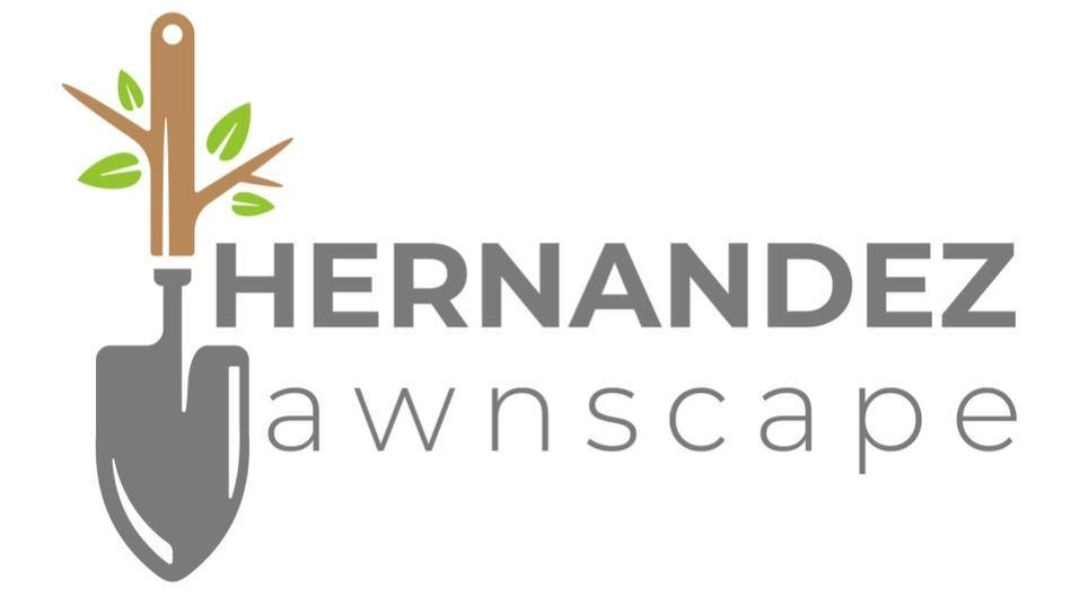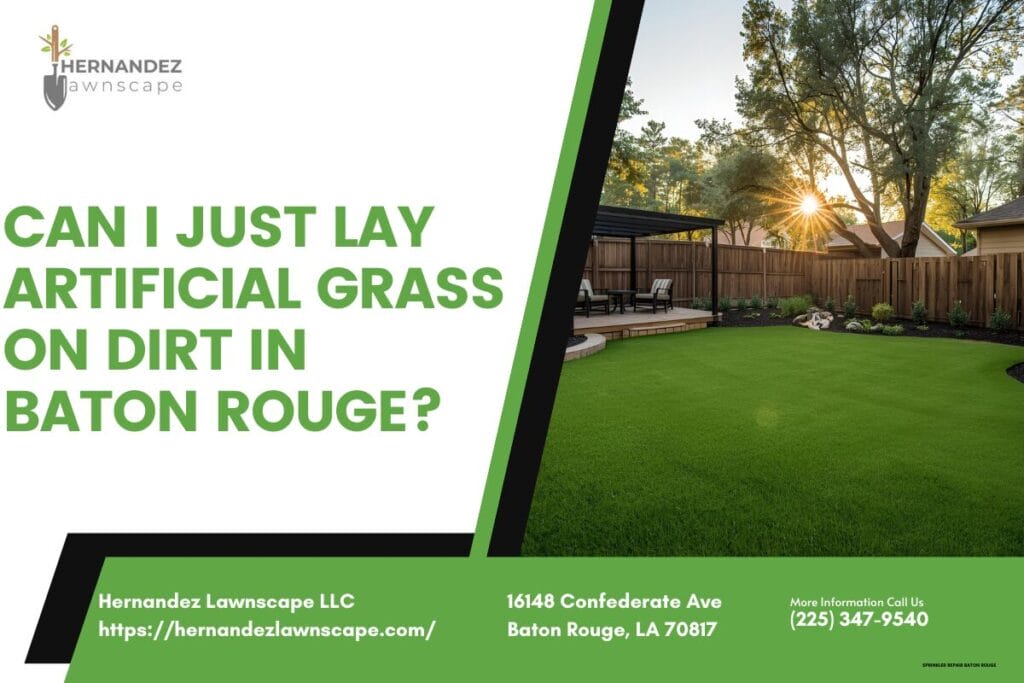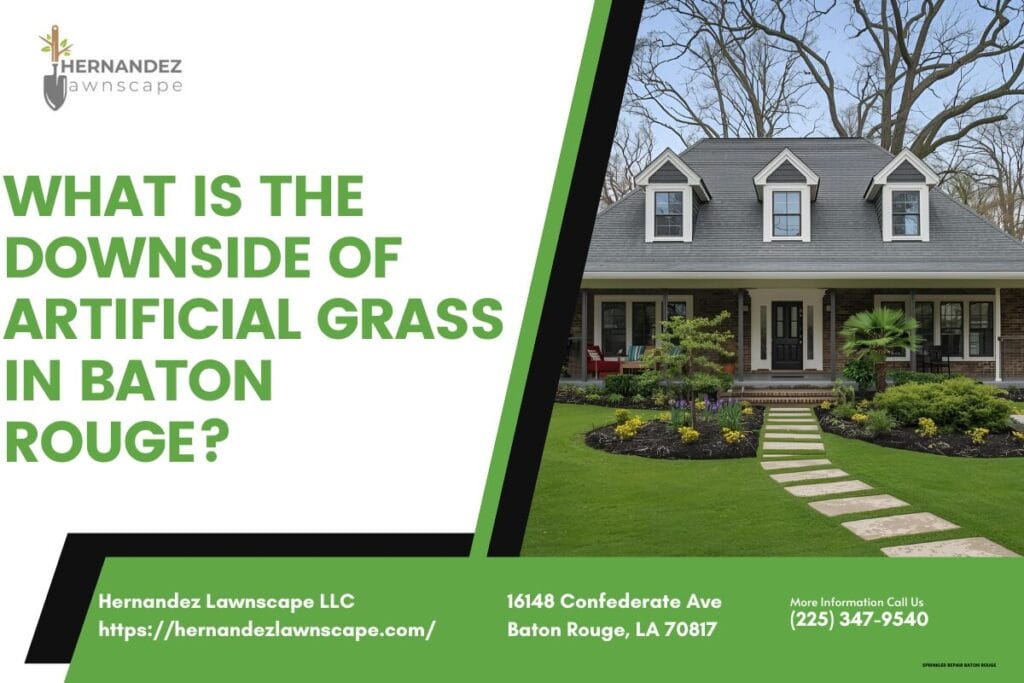The three main types of drainage in Baton Rouge are not just the fixtures in your yard, but rather three interconnected scales of defense: Property-level systems that combat heavy rain, Municipal infrastructure that manages overflowing bayous, and Regional water management that protects against catastrophic river and coastal events. Understanding how these three layers work together is the key to solving lawn saturation issues and protecting your home’s foundation from water damage.
The Real Reason for Soggy Lawns in Louisiana: The Three Flood Threats We Face
Here at Hernandez Lawnscape, we’ve been providing professional landscape drainage services in and around Baton Rouge for over two decades. A question we hear constantly is, “What are the main drainage types for homes?” Most people expect an answer like “French drains, catch basins, and swales.” While those are tools we use, they are not the “types” of drainage. They are just one piece of a much larger puzzle.
To truly understand drainage in our city, from the historic Garden District to the newer developments along Perkins Road, you first have to understand what we’re fighting against. Our beautiful state is uniquely vulnerable to water. In fact, Louisiana communities face threats from three major types of flooding: pluvial (flash flooding), fluvial (river flooding) and coastal flooding. These aren’t abstract concepts; they are the root causes of nearly every drainage problem a Baton Rouge homeowner will ever face.
Threat 1: Pluvial Flooding (The Sudden Downpour)
This is the most common enemy for the average homeowner. Pluvial flooding occurs when rain falls faster than drainage systems can handle, and it can happen anywhere, not just near large bodies of water. Think of those intense summer thunderstorms that turn Nicholson Drive into a temporary river. This is the water that causes pooling on your concrete patio, creates a soggy lawn, and threatens your home’s foundation. It’s the primary reason for fixing backyard flooding issues on a residential property.
Threat 2: Fluvial Flooding (The Rising Bayous)
Fluvial flooding is caused by excess rain causing a river to rise higher than its normal level, which can also impact smaller streams and bayous. For us in Baton Rouge, this means the Amite River, Comite River, and local waterways like Ward Creek or Bayou Fountain swelling beyond their banks. This type of flooding affects entire neighborhoods and tests the limits of our city’s infrastructure. It’s a larger-scale problem that requires a larger-scale solution than just a single yard drain.
Threat 3: Coastal Flooding (The Hurricane Surge)
While Baton Rouge isn’t directly on the coast, we are certainly not immune to the effects of major storms. Coastal flooding, or storm surge, is most common during severe weather events like hurricanes, where wind during high tide causes large waves to flood coastal properties. The massive volume of water pushed inland can back up rivers and tributaries for miles, compounding our fluvial and pluvial flooding problems. This is the “big one” that our largest defenses are built to withstand.
A Three-Layered Defense: The True Types of Drainage in Our Community
Now that we understand the threats, we can see that a single French drain installation is not a magical cure-all. Effective water runoff management in Baton Rouge is a coordinated effort across three distinct scales, or “types,” of drainage systems. Think of it as a layered defense for your home and our city.
Level 1: Property-Level Defense (The Micro Scale) – Your First Line of Defense
This is the level you have the most control over. These are the outdoor drainage systems on your property designed almost exclusively to combat pluvial flooding—that sudden, heavy rain. When your yard turns into a swamp after a storm, it’s typically a failure at this micro-level. The goal here is to manage the water that falls directly on your land, protecting your home’s foundation and creating usable, beautiful outdoor spaces.
Common property-level systems include:
- Landscape Grading for Water Runoff: This is the most fundamental principle. Your soil should be graded to slope away from your house. Correcting negative grade drainage, where the yard slopes toward your foundation, is the first step in preventing foundation water damage. A professional yard regrading service in Baton Rouge can reshape your lawn to ensure water flows where you want it to go.
- French Drains: A French drain is one of the most popular subsurface drainage systems. It’s essentially a gravel-filled trench with a perforated pipe that collects subsurface water and directs it away. Many people ask us, “how do French drains work in clay soil?” Our heavy Baton Rouge clay can be a challenge, but with proper design, including the right fabric liner and gravel, they are highly effective for solving lawn saturation issues.
- Catch Basins and Channel Drains: These are designed for improving surface water drainage. A catch basin is a collection box placed at a low point in your yard to capture standing water, while channel drains for driveways (also called trench drains) are long, narrow grates that prevent water from pooling on hardscapes like patios or entering your garage.
- Downspout and Gutter Drainage Systems: Managing roof runoff water is critical. A single inch of rain on a 1,000-square-foot roof produces over 600 gallons of water. Directing this water away from your foundation using solid, buried pipes is a simple but powerful residential water diversion system.
- Permeable Paver Drainage Systems: For new patios or walkways, permeable pavers are an excellent choice. They allow rainwater to seep through the surface into a gravel base below, reducing surface runoff and replenishing groundwater.
Effectively designing and implementing these property water drainage systems is our specialty at Hernandez Lawnscape. We conduct a thorough yard drainage assessment and consultation to determine the best approach for your specific situation, whether it’s a simple swale and berm construction or a complex network of subsurface drains. As one of our clients recently noted, “I could not be more pleased with Hernandez Lawnscape. Excellent service all around…5 stars!” We believe that protecting your most valuable asset starts right here, in your own yard.
Level 2: Municipal Infrastructure (The Meso Scale) – Your Neighborhood’s Network
Once water leaves your property through a drain or by flowing to the street, it enters the second layer of defense: the municipal drainage system maintained by the City of Baton Rouge and East Baton Rouge Parish. This network is the primary defense against localized fluvial flooding from overflowing streams and bayous and is essential for handling the collected pluvial runoff from thousands of properties.
This meso-level system includes:
- Roadside Ditches and Culverts: The open ditches you see along many Baton Rouge roads are the workhorses of our drainage system. They act as channels to move large volumes of water toward larger canals and streams. Culverts are the pipes that allow this water to flow under roads and driveways.
- Storm Sewers: In more developed areas, especially downtown and in denser subdivisions, runoff is collected by storm drains on the street and transported through a massive underground network of pipes.
- Canals and Larger Waterways: This network eventually feeds into larger, parish-maintained channels like the Corporate Canal or Dawson Creek, which are designed to move water efficiently to major rivers.
The effectiveness of this municipal system is critical. A clogged culvert a block away from your home can cause water to back up and flood your entire street, rendering your perfect property-level system useless. This is why Baton Rouge stormwater runoff regulations exist—to ensure new construction and development don’t overwhelm the existing infrastructure. Any major work, such as a large catch basin installation in East Baton Rouge Parish, often requires a residential drainage permit to ensure it ties into the city system correctly.
Level 3: Regional Water Management (The Macro Scale) – The Unseen Shield
The final layer of defense is the massive, often unseen regional infrastructure designed to protect us from catastrophic fluvial and coastal flooding events. These are the large-scale public works projects that manage the Mississippi River and protect huge swaths of our region from hurricane storm surge.
This macro-level system includes:
- The Mississippi River Levee System: This is perhaps the most famous piece of water management infrastructure in the country. This massive earthen wall contains the immense power of the Mississippi, protecting Baton Rouge from what would otherwise be regular, devastating river flooding.
- The Comite River Diversion Canal: A prime example of a regional project designed to mitigate fluvial flooding. This canal is engineered to divert floodwaters from the Comite River, protecting thousands of homes in areas like Central and Denham Springs that were heavily impacted in the 2016 flood.
- Spillways and Control Structures: Structures like the Morganza Spillway are designed as emergency release valves to divert Mississippi River floodwaters away from populated areas like Baton Rouge and New Orleans, protecting the integrity of the entire levee system.
You have no direct control over this system, but your safety depends on its maintenance and effectiveness. When these systems are overwhelmed, as we saw in 2016, the consequences are widespread and severe. It’s a stark reminder that we live in a delicate balance with the water that surrounds us.
A System of Systems: Why Your Drainage is Only as Strong as its Weakest Link
The most crucial takeaway is that these three levels are not independent; they are completely interconnected. A failure at any level can cause a cascade of problems.
Imagine you hire the best contractors for yard drainage in Baton Rouge to install a state-of-the-art French drain system. The installation is flawless. The next time a heavy rain comes, the system collects all the standing water from your yard and channels it to the storm drain at the street, just as designed. But what if the municipal ditch or storm sewer it connects to is clogged with leaves and debris two blocks down? The water has nowhere to go. It will back up out of the storm drain, flooding the street and eventually your yard, completely defeating the purpose of your expensive property-level solution.
This is why a holistic approach is necessary. As a homeowner, your responsibility includes maintaining your own systems and also being a good steward of the municipal system. This means not blowing leaves and grass clippings into the street, where they can wash into and clog storm drains. It means reporting blocked culverts or ditches to the city. A healthy drainage ecosystem for Baton Rouge relies on both robust infrastructure and active community participation.
Comparing Baton Rouge’s Drainage Defenses: Pros, Cons, and Realities
Understanding which system addresses your specific problem is key to finding the right solution. Here’s a breakdown of the key factors for each level of defense.
Property-Level Defense (Your Yard)
Primary Role:
Manages pluvial (heavy rain) flooding on your specific property. Protects your foundation, eliminates standing water, and prevents soil saturation problems.
Pros:
- You have direct control over its design, installation, and maintenance.
- Can be customized to the unique challenges of your landscape (e.g., best drainage for clay soil, solutions for sloped yards).
- Relatively fast to implement. A project like a French drain installation can often be completed in a few days.
Cons:
- Can be costly, depending on the scale. The cost of a French drain in Baton Rouge can range from a few thousand to over ten thousand dollars.
- Completely dependent on the municipal system it drains into. It cannot solve neighborhood-wide flooding.
- Requires regular drainage system maintenance LA to remain effective.
Municipal-Level Defense (Your Neighborhood)
Primary Role:
Collects runoff from multiple properties and manages fluvial (stream/bayou) overflow on a neighborhood or city-section scale.
Pros:
- Handles a much larger volume of water than any single property system can.
- Funded and maintained by the city/parish, not individual homeowners.
- Provides a necessary outlet for all property-level drainage systems.
Cons:
- You have very little direct control. Maintenance is subject to public works schedules and budgets.
- Can be overwhelmed during extreme rain events, leading to widespread street and property flooding.
- Vulnerable to blockages from debris and illegal dumping.
Regional-Level Defense (Our Region)
Primary Role:
Protects entire parishes from catastrophic fluvial (major river) and coastal (storm surge) flooding.
Pros:
- Provides protection against the most destructive and widespread flooding events.
- Engineered to the highest standards to protect critical infrastructure and population centers.
Cons:
- Completely outside of individual control; managed by state and federal agencies.
- A failure in this system is catastrophic and impacts everyone downstream.
- Provides no protection against localized pluvial (heavy rain) flooding; your yard can still flood behind a perfect levee.
Answering Your Key Drainage Questions
Navigating water issues can be confusing. Here are some quick answers to common questions we hear from Baton Rouge residents.
What are the drainage laws in Louisiana?
In Louisiana, the law generally follows a “natural servitude of drain” principle. This means a lower-elevation property is obligated to receive the natural surface water runoff from a higher-elevation property. However, the owner of the higher property cannot do anything to make the runoff worse (e.g., concentrating it in one spot or increasing the volume). This is why properly engineered landscape water diversion techniques are so important, and why certain projects require a permit to comply with local Baton Rouge city drainage requirements.
What is the most common drainage system?
This depends on the scale. For a homeowner in Baton Rouge, the most common professionally installed systems are French drains and catch basins, combined with proper grading. For the municipality, the most common systems are open ditches and subterranean storm sewer pipes. One is not “better,” they simply operate at different scales to accomplish the same goal: moving water safely.
Where does Baton Rouge water come from?
Our drinking water is sourced from a fantastic underground aquifer system called the Southern Hills Aquifer. However, all our drainage problems come from surface water—the rain that falls from the sky and the water that flows through our rivers and bayous.
Making the Right Choice for Your Needs
There is no single “best” drainage solution. The right approach depends entirely on your location, your property’s specific issues, and the primary flood risk you face. We believe in being honest and trustworthy advisors for our clients. As one customer put it, “They always go a step beyond what I expect and consistently provide excellent service. Mr. Hernandez is honest and trustworthy and provides strong leadership for his company.” With that in mind, here is our tailored advice for different types of Baton Rouge residents.
For “The Urban Homeowner” (e.g., in Mid City, Southdowns, or a dense subdivision)
Your primary concern is pluvial flooding from intense rainfall overwhelming your lot and the local storm drains. Your focus should be squarely on property-level defenses. A yard drainage assessment and consultation is your best starting point. Solutions will likely involve correcting poor yard drainage with grading, installing a French drain or catch basin system to handle low spots, and ensuring your downspouts are effectively moving roof water away from your foundation.
For “The Bayou-Side Resident” (e.g., living near Ward Creek, Bayou Manchac, or the Amite River)
You face a dual threat: pluvial flooding from rain and fluvial flooding from rising water levels. While you rely on municipal ditches and canals as your first major defense against rising bayous, these systems can be stressed. Your property-level systems must be robust. In addition to standard drains, consider retaining wall drainage solutions if you have a sloped yard, and focus on erosion control for Louisiana properties to keep your valuable land from washing away during high-water events.
For “The Coastal-Aware Property Manager” (e.g., managing commercial properties or subdivisions in the broader region)
You understand the macro threat of hurricane-related flooding. You depend on the regional levee and canal systems for ultimate protection, but you also know that these storms bring unimaginable amounts of rain (pluvial flooding). Your strategy must be comprehensive. This means implementing robust commercial drainage solutions on the property, ensuring all municipal connections are clear and functional before a storm, and developing stormwater management solutions that can handle the deluge that precedes and accompanies any potential storm surge.
Ultimately, a functional and beautiful outdoor space is one that you can enjoy without worry. Correcting drainage issues is the first and most critical step toward protecting your investment and creating that peace of mind. As your local lawn drainage expert near me, Hernandez Lawnscape has the experience to diagnose your specific problem and design a system that works with, not against, Baton Rouge’s unique water challenges. For a personalized assessment of your property and a clear plan of action, we invite you to get a quote for yard drainage from our expert team today.




